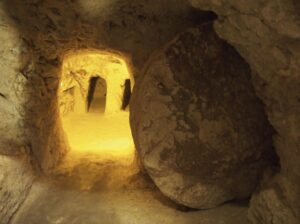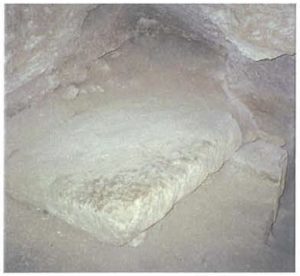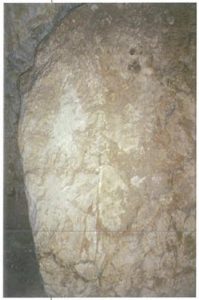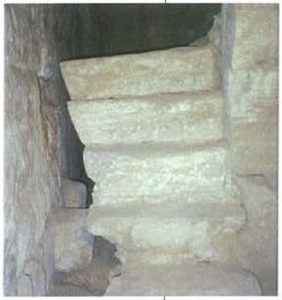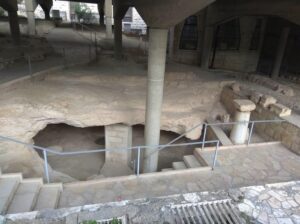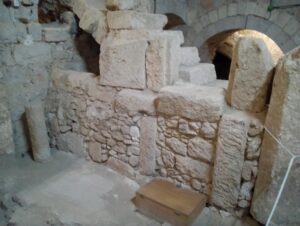Published in June 2022. Last update: August 2022.
Summary
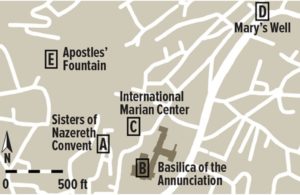 Is Jesus of Nazareth’s childhood home located at the Sisters of Nazareth convent location?
Is Jesus of Nazareth’s childhood home located at the Sisters of Nazareth convent location?
Historically, there have been two primary locations associated with the announcement to Mary by the angel Gabriel that she would give birth to Jesus. For the western tradition, it is the Church (or Basilica) of the Annunciation. For the eastern tradition, it is Mary’s Well. The archaeological site at the Sisters of Nazareth convent location is about 500 ft. away from the Church of the Annunciation.
The sisters have always been aware of the possibility, since taking possession back in the mid 1800’s, that it could be the site of Jesus’ childhood home. But over the years, no one really wanted to make a big deal about it for political reasons. As well, it should be mentioned from the outset, there is not clear proof either way.
Fortunately, political concerns have been diminishing over time, allowing those with an interest in solving Biblical mysteries to develop this line of research. In 2006, the Nazareth Archaeological Project got involved, leading to numerous publications by Prof. Ken Dark. The inconclusive efforts indicate the site is, at least, as worthy of consideration as the other two.
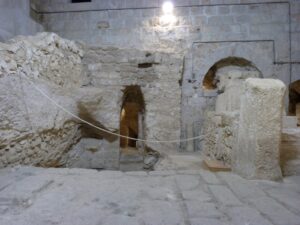
One-room home, hearth on the left. Plus, eventually, the addition through the door for a workshop and sleeping quarters.
However, in 2000, amateur archaeologist Stephen Shanahan, using Urantia Book descriptions of the location of Jesus’ home, found that the Sisters of Nazareth convent site was the best fit. And more importantly, he was able to identify two stone slabs at the site that are consistent with The Urantia Book’s description of the family dining table at the Nazareth home.
Apparently, the nature of the stone slabs—large and plain—helped them survive and remain roughly in situ. They could not be easily removed and their historical significance is not readily apparent. Even still, the placement of one of the slabs in a tomb suggests that it was considered a significant artifact.
Usually, UBtheNEWS reports related to new discoveries that support statements made in The Urantia Book. In this case, not only does the Sisters of Nazareth archaeological site lend credibility to The Urantia Book, as well, it in turn helps identify which of the archaeological sites is the best candidate for Gabriel’s appearance to Mary.
(Much thanks goes to Rev. Robert Crickett, who got in touch with me in response to this report’s publication. He has many times traveled to Israel and regularly lodged with the Sisters of Nazareth on those trips. The information and images he provided are re-presented at the end of this report.)
Sisters of Nazareth convent location
In his memoir “Providence and the Secret of Nazareth,” amateur archaeologist Stephen Shanahan provides a brief summary of this site’s peculiar early history:
“In the 17th century, the Franciscans were the first Christians to establish themselves in Nazareth since the crusader times. From the 12th century the area has [sic, had?] been under Muslim control.
“As a side note, three times Muslims tried to construct a minaret on the site of the convent and three times it mysteriously collapsed so they “got the message” and built the mosque elsewhere.”
In 1881, French nuns established the Sisters of Nazareth convent. A construction project led to the discovery of the archaeological site.
The Madain Project, a resource for “Abrahamic History and Archaeology,” has a page dedicated to this topic. Its “References” section is noteworthy for including references that date back to 1923.
Archaeologist Ken Dark serves as director of the Research Centre for Late Antiquity and Byzantine Studies at the University of Reading. His involvement with the Nazareth Archaeological Project has led to numerous publications that discuss the significance of the research. This 2015 Biblical Archaeology Society article reviews the abundance of circumstantial evidence that supports consideration of the Sisters of Nazareth convent location.
An article, based on Dark’s book, The Sisters of Nazareth Convent: A Roman-period, Byzantine, and Crusader site in central Nazareth, both published in 2020, concludes with these remarks:
“The house in the church crypt is said in De Locis Sanctis to be the childhood home of Jesus. Consequently, identifying the Byzantine church at the Sisters of Nazareth site as the Church of the Nutrition, of course, raises the question of whether Structure 1 could really have been the childhood home of Jesus. Despite speculation in the international media, often misreporting my position on this subject, my view is that it is impossible to tell whether this identification was correct.
“A local tradition could have been preserved in, or near, Nazareth that this was where Jesus had been brought up, but the attribution could have been a complete invention. There is no way that archaeological or historical study can decide between these options on current evidence.
“All that it is possible to say is that Structure 1 was probably believed from at least the fifth, and probably the fourth, century to have been where Jesus was brought up. Nevertheless, the site does shed new light on first-century Nazareth and, in that respect, is relevant to the Bible and its interpretation.”
Dark’s work with the Nazareth Archaeological Project is notable for the professional effort that it brings to the study of the site. Before that work started, the site was not completely closed off to tourists. In fact, hotel services have been available at times and tourists and, sometimes, they received tours.
In 2000, emboldened by The Urantia Book’s claim that its “historic facts … will stand on the records of the ages to come,” Stephen Shanahan and Martin McBurney embarked on a lay archaeological expedition to Israel. Jesus’ Nazareth home and the burial tomb were at the top of the list. Providence & the Secret of Nazareth by Stephen Shanahan provides a first hand account of his time in Nazareth, as a guest at the Sisters of Nazareth convent. Additionally, they engaged the services of Dr. Kujawa published Jerusalem Diary: Searching For The Tomb And House Of Jesus in 2012. (See excerpt.)
The Urantia Book teaches that Mary and Joseph had eight more children after Jesus, which necessitated extending the original table. All four of the references to a “stone table” in The Urantia Book are used to identify the family table at the Nazareth home.:
(122:3.1) One evening about sundown, before Joseph had returned home, Gabriel appeared to Mary by the side of a low stone table and, after she had recovered her composure, said: “I come at the bidding of one who is my Master and whom you shall love and nurture. To you, Mary, I bring glad tidings when I announce that the conception within you is ordained by heaven, and that in due time you will become the mother of a son; you shall call him Joshua, and he shall inaugurate the kingdom of heaven on earth and among men. Speak not of this matter save to Joseph and to Elizabeth, your kinswoman, to whom I have also appeared, and who shall presently also bear a son, whose name shall be John, and who will prepare the way for the message of deliverance which your son shall proclaim to men with great power and deep conviction. And doubt not my word, Mary, for this home has been chosen as the mortal habitat of the child of destiny. My benediction rests upon you, the power of the Most Highs will strengthen you, and the Lord of all the earth shall overshadow you.”
(122:6.2) The home of Joseph and Mary was a one-room stone structure with a flat roof and an adjoining building for housing the animals. The furniture consisted of a low stone table, earthenware and stone dishes and pots, a loom, a lampstand, several small stools, and mats for sleeping on the stone floor. In the back yard, near the animal annex, was the shelter which covered the oven and the mill for grinding grain. …
(126:3.4) At last Jesus gave up the idea of having each member of the family formulate spontaneous prayers, and one evening in October he sat down by the little squat lamp on the low stone table, and, on a piece of smooth cedar board about eighteen inches square, with a piece of charcoal he wrote out the prayer which became from that time on the standard family petition.
The slab lying flat had a thickness measuring from 22-25 cms. The thickness of the one leaning against a wall measured 21-25 cms. Stephen Shanahan comments that, if residue tests were performed on these stones, the results could be especially insightful.
Two other aspects of the Sisters of Nazareth convent location also bear mentioning–a set of stairs and a stone for playing board games.
(123:4.5) The only real accident Jesus had up to this time was a fall down the back-yard stone stairs which led up to the canvas-roofed bedroom. It happened during an unexpected July sandstorm from the east. The hot winds, carrying blasts of fine sand, usually blew during the rainy season, especially in March and April. It was extraordinary to have such a storm in July. When the storm came up, Jesus was on the housetop playing, as was his habit, for during much of the dry season this was his accustomed playroom. He was blinded by the sand when descending the stairs and fell. After this accident Joseph built a balustrade up both sides of the stairway.
(124:1.13) Jesus continued to grow physically, intellectually, socially, and spiritually. His trips away from home did much to give him a better and more generous understanding of his own family, and by this time even his parents were beginning to learn from him as well as to teach him. Jesus was an original thinker and a skillful teacher, even in his youth. He was in constant collision with the so-called “oral law,” but he always sought to adapt himself to the practices of his family. He got along fairly well with the children of his age, but he often grew discouraged with their slow-acting minds. Before he was ten years old, he had become the leader of a group of seven lads who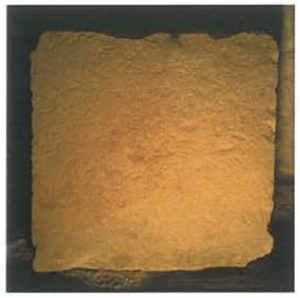 formed themselves into a society for promoting the acquirements of manhood—physical, intellectual, and religious. Among these boys Jesus succeeded in introducing many new games and various improved methods of physical recreation.
formed themselves into a society for promoting the acquirements of manhood—physical, intellectual, and religious. Among these boys Jesus succeeded in introducing many new games and various improved methods of physical recreation.
Hopefully, Prof. Ken Dark and the Nazareth Archaeological Project will continue their efforts to dig deeper in the mystery surrounding the location of Jesus’ home in Nazareth and come up with something definitive. For now, The Urantia Book apparently stands as the best source for narrowing the search down to the Sisters of Nazareth convent location.
From Rev. Robert Crickett
The following is a re-presentation of communications, images, and articles provided by Rev. Robert Crickett:
“Before compiling Sr. Margareta’s talks into a coherent sequence with relevant photos, however, I shall share something with you which I feel certain you will find very interesting.
“In 1993, Mr. Stephen Shanahan of Melbourne Australia researched the whereabouts of the original home of Jesus’ family in Nazareth. He used the Urantia Book’s directions, re the market place, the well, the Hill of Nazareth etc.. The ancient market place is still just up the hill and around the corner from the holy family home.
“Stephen located the home at the Sisters of Nazareth Convent. In those days 1993-1994 it seemed that all the resident Sisters believed their convent location to be the home of the holy family. Stephen stayed a couple of nights there in the convent, not knowing about the excavations beneath the outdoor courtyard with its statue of Joseph, Mary and the lad Jesus.
“When one of the sisters asked him his reason for being in Nazareth he explained that he was searching for the original home of Jesus . . . and that he knew for sure that it wasn’t the Basilica of the Annunciation, and everything pointed to this area where he was, but he didn’t know where the holy family home could possibly be. With a big heart full of love the believing Sisters of that day eagerly showed him the excavations. Stephen journeyed to France afterwards and upon his return to Melbourne told me that he had found the holy family home. More than that, he showed me a booklet he had copied in France in the home of the author, a Jesuit priest by the name of Fr. Jean-Bernard Live S.J. This man had documented the history of the excavations at the Sisters of Nazareth Convent.
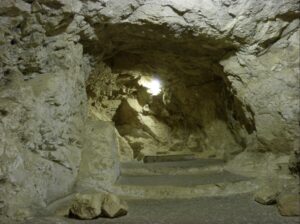 “Thus it was that, when I went there on pilgrimage in 1994 with my wife Mary, we were shown the excavations by the elderly Italian, Sister Margareta, a believer.
“Thus it was that, when I went there on pilgrimage in 1994 with my wife Mary, we were shown the excavations by the elderly Italian, Sister Margareta, a believer.
“When I began my world ministry in 2001, it was she who conducted the tours of the excavations every time I annually took a group of pilgrims to the convent as one aspect of my ministry, hence my recordings of Sr. Margareta speaking.
“The Sisters of Nazareth is a French Order of primary school teaching nuns. Directly opposite them in Nazareth, for example, is the school they founded in Nazareth. In later years, however, Sister Margareta returned to Spain or France. A slightly younger sister who was newly arrived in Israel took over the task of showing guests, pilgrims and visitors the excavations. Perhaps after a while she was negatively affected by running the tours. Perhaps some visitors might have argued against the site being the holy family’s home. Or perhaps she preferred to stick to the Catholic Church’s story that the Basilica down at the end of the street was the real location of the holy family home. Regardless, she had soured to the idea and was a devout unbeliever and appeared to treat her role as tour guide of the excavations as though it was a most onerous task that she would rather be rid of as soon as possible.
“My pilgrims noticed her attitude, and her desire to reshape the excavations so that they no longer resembled “the holy family home” and were simply evidence of an early Christian home, with tomb cavities beneath it, and with evidence of one-time Crusader presence. It seemed to me that by so doing she would personally avoid conflict between the two sites, the convent with its extensive evidence, and the home beneath the mighty stone construction of the Catholic Church’s Basilica of the Annunciation standing in regal glory and pomp just a hundred yards away.
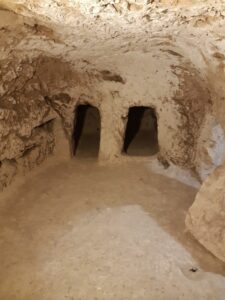 “On a later pilgrimage, however, in 2014, a different and older sister conducted the tours of the excavations. Here again was a true believer. I commented about the unbelieving sister and the brevity of her explanations, her attitude, and the paucity of reverence she held for the excavations. The sister burst out laughing, “Oh her. Well, never you mind about her. I am a total believer. We all are. Come with me, all of you, and I will show you the real home of our Lord Jesus Christ and the holy family home, the place of our Lady, the Mother of God.” And, to my delight, it was all on again! Praise God! It appeared that the other Sister had also been requested to Spain or France, there was no sign of her at the convent.
“On a later pilgrimage, however, in 2014, a different and older sister conducted the tours of the excavations. Here again was a true believer. I commented about the unbelieving sister and the brevity of her explanations, her attitude, and the paucity of reverence she held for the excavations. The sister burst out laughing, “Oh her. Well, never you mind about her. I am a total believer. We all are. Come with me, all of you, and I will show you the real home of our Lord Jesus Christ and the holy family home, the place of our Lady, the Mother of God.” And, to my delight, it was all on again! Praise God! It appeared that the other Sister had also been requested to Spain or France, there was no sign of her at the convent.
“Interestingly, all these Sisters ran the same script on the tour of the excavations. It was Sister Margareta’s type-written script. The unbelieving Sister simply skimmed over some bits of it that showed some of the excavations to be the holy family’s home.
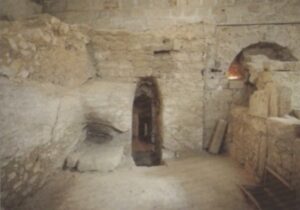
Low stone table placed at the hearth of the one-room home. Later is was removed during further excavations. (See first image above.)
“Another interesting feature is that on my first tour of the holy family’s home, in 1994, the stone table was in the exact center of the room. Unmoved by time. It was very easy to imagine Joseph and Mary and the kids all seated on the floor around this table. By the time I came on my second pilgrimage, September 2001, with the late William MacLean of Australia (d. 2016), the late Henry Zeringue of California (d.2021), and Matti Heinonen of the Immigration Department, Helsinki Finland, the table had been moved to the edge of the room, as in the following photo I have on a post card from those earlier years of pilgrimage.
“Also, I have seen …, since then, more extensive excavations have been made and that the holy family home is no longer as it was. The diggings have removed enough of the home floor such that it no longer resembles the floor. It was once that one would come to the front door entrance, step up across the hearth and step down to enter onto the home floor wherein lay the stone table. Nowadays, the floor has been gutted so that the front step doesn’t abut the door hearth but one steps down onto a flattened area instead of the floor of the home.
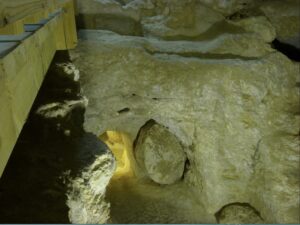 “Beneath the home is a large room of tomb chambers where Joseph would have been laid after his accidental death. It was customary for families to bury their members beneath the home so that the family was on the one plot of land, and this is typical of the Nazareth situation in Jesus’ day. In this pic you will notice that the tomb stone is rolled away to the right but it is still very present. Sr. Margareta and the last tour guide Sister both mentioned something very interesting. There is a hole in the house floor and it has a stone covering it, a hole of about a foot by a foot. Before ever knowing that there was a tomb chamber below the house, one of the sisters moved that covering stone and a big waft of incense rushed out of the tomb below. Christians had worshipped there in days bygone. When the Sisters entered the tomb chamber they found a pair of Crusader Knight’s spurs. Some man eight hundred years ago left his presence in the Lord’s house.”
“Beneath the home is a large room of tomb chambers where Joseph would have been laid after his accidental death. It was customary for families to bury their members beneath the home so that the family was on the one plot of land, and this is typical of the Nazareth situation in Jesus’ day. In this pic you will notice that the tomb stone is rolled away to the right but it is still very present. Sr. Margareta and the last tour guide Sister both mentioned something very interesting. There is a hole in the house floor and it has a stone covering it, a hole of about a foot by a foot. Before ever knowing that there was a tomb chamber below the house, one of the sisters moved that covering stone and a big waft of incense rushed out of the tomb below. Christians had worshipped there in days bygone. When the Sisters entered the tomb chamber they found a pair of Crusader Knight’s spurs. Some man eight hundred years ago left his presence in the Lord’s house.”
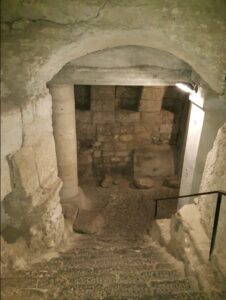 “When taking the tour of the excavations, one descends these stairs and railing that take a person down to the street level of Jesus’ day.
“When taking the tour of the excavations, one descends these stairs and railing that take a person down to the street level of Jesus’ day.“On the outside walls of the holy family home there are stone stairs rising up to where the roof once was. Sister Margareta commented that these steps were built in the Crusader fashion and would not have been original to the holy family home. Still, we are mindful of how Joseph built stairs up to the roof where the males of the family would sleep on the hot nights, and still do in the Middle East, and where during the day time Mary taught Jesus with the sandbox . . . and how in a sand storm one day Jesus fell down the stairs . . . probably made from timber . . . and how the angels watching over Jesus were found not negligent of his care because the storm was unpredictable and sudden.”
